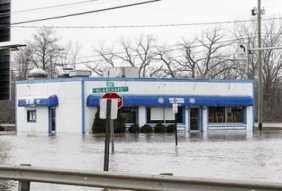
Posted on May 17, 2016
By Nolan Rosenkrans, The Blade
Hancock County and Findlay officials soon may be forced to abandon a Blanchard River flood-control project or pay for the project with local money because federal funding might not be available.
The U.S. Army Corps of Engineers has been studying ways to mitigate flood damage in the Findlay area since 2006. The plan would involve a more than nine-mile diversion of Eagle Creek, through which water would flow during heavy precipitation so it would not dump into the Blanchard in Findlay.
But a review by the Corps in recent months found the project’s cost-benefit ratio was significantly less than previously projected, which would make the project ineligible for a 65 percent match in federal funds, said Mike Pniewski, a corps project manager.
However, the corps is using a new hydrology and hydraulics model that accounts for changes in flooding frequency in recent years, which could increase the cost-benefit ratio and make the diversion eligible for matching funds.
Rainfall has been less frequent but more intense in recent years, and land usage has changed in the past 20-25 years, making historic rates of flooding a potentially inaccurate indicator for what will happen in the future. The new approach uses local data that shows a “clear and definite” change in the area, said David Schulenberg of the corps.
“What we are finding, especially in this area of the country, is that [past data] really isn’t reflective of what is actually happening,” Mr. Pniewski said.
The cost of the project increased from an estimated $60 million to about $80 million, according to the corps. That’s a hefty price, but less than the $100 million in damage caused to Findlay in a 2007 flood.
Steve Wilson, a Hancock County engineer who is the local project manager, said the county has about $16 million in reserves generated from a 0.25 percent sales tax approved by voters in 2009 for flood mitigation.
There’s no feasible alternative other than the Eagle Creek diversion, Mr. Wilson said, so if the corps can’t continue with the project, local officials will have to decide to do nothing or complete the project on their own.
“That’s a decision that the locals are trying to make at this point,” Mr. Wilson said.
Beyond the financial cost, there are political calculations. While many support the proposed project, others don’t, as government entities would have to buy land to build the diversion, Mr. Wilson said. There’s also the matter of time, as the corps’ study wouldn’t be complete until the spring of 2017. After that, Congress would have to appropriate money for the project.
Findlay and Hancock County might not want to wait that long to get started, as the local data has shown the region is more prone to major flooding than in the past.
“We’d have to make the decision pretty quickly whether or not we want to continue to wait or make a decision on our own,” Mr. Wilson said.
Source: The Blade





